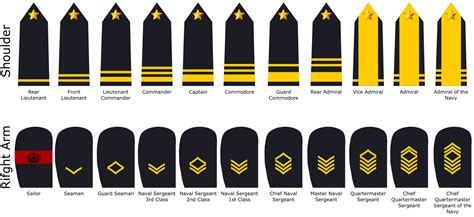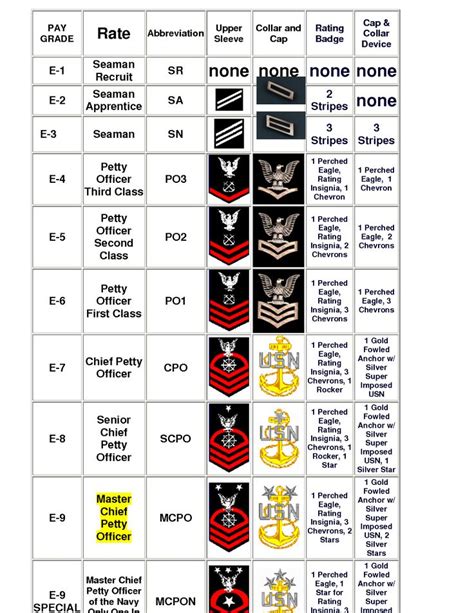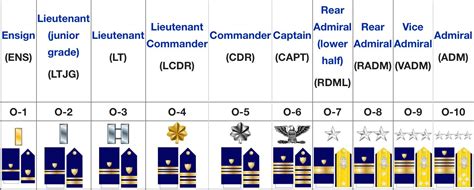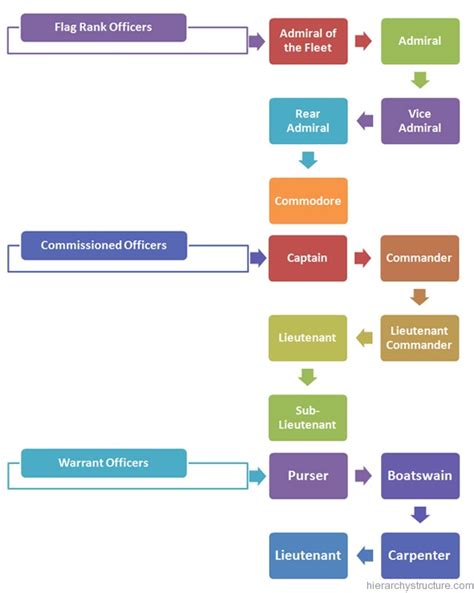The United States Navy, like other military branches, operates on a strict hierarchical structure. This hierarchy is essential for maintaining order, discipline, and effective communication within the organization. The Navy's rank structure is divided into three main categories: enlisted, warrant officer, and commissioned officer. Understanding the different ranks and their responsibilities is crucial for navigating the complexities of naval operations.
At the foundation of the Navy's hierarchy are the enlisted personnel, who make up the majority of the force. Enlisted sailors are divided into nine pay grades, from E-1 (Seaman Recruit) to E-9 (Master Chief Petty Officer). Each pay grade represents a higher level of responsibility, expertise, and authority. Enlisted personnel are responsible for performing specific jobs, known as ratings, which range from aviation mechanics to cryptologic technicians. As sailors gain experience and advance in rank, they take on more complex tasks and leadership roles within their respective ratings.
Key Points
- The Navy's hierarchy is divided into enlisted, warrant officer, and commissioned officer categories.
- Enlisted personnel make up the majority of the force and are responsible for performing specific jobs or ratings.
- Warrant officers are technical experts who provide guidance and support to enlisted personnel and commissioned officers.
- Commissioned officers are responsible for leading and commanding naval units, making strategic decisions, and overseeing operations.
- The Navy's rank structure is designed to promote professionalism, discipline, and effective communication.
Enlisted Ranks and Responsibilities

The enlisted ranks are further subdivided into three categories: junior enlisted (E-1 to E-4), non-commissioned officers (E-5 to E-6), and senior enlisted (E-7 to E-9). Junior enlisted personnel typically perform entry-level tasks and are still developing their skills and expertise. Non-commissioned officers have gained more experience and take on leadership roles, mentoring junior sailors and overseeing specific tasks. Senior enlisted personnel are highly experienced and serve as technical experts, providing guidance and counsel to junior sailors and officers alike.
Warrant Officers: Technical Experts
Warrant officers are technical experts who have advanced knowledge and skills in specific areas, such as aviation, communications, or intelligence. They are responsible for providing guidance and support to both enlisted personnel and commissioned officers. Warrant officers are appointed by a warrant, which is a special commission that recognizes their expertise and authority. There are five warrant officer ranks in the Navy, ranging from W-1 (Warrant Officer 1) to W-5 (Chief Warrant Officer 5).
| Enlisted Rank | Pay Grade | Responsibilities |
|---|---|---|
| Seaman Recruit | E-1 | Entry-level tasks, basic training |
| Petty Officer Third Class | E-4 | Leadership roles, mentorship, task oversight |
| Chief Petty Officer | E-7 | Technical expertise, guidance, counsel |

Commissioned Officers: Leadership and Command

Commissioned officers are responsible for leading and commanding naval units, making strategic decisions, and overseeing operations. They are divided into two categories: line officers and staff officers. Line officers are responsible for commanding ships, squadrons, and other operational units, while staff officers provide support and expertise in areas such as logistics, personnel, and intelligence. Commissioned officers are appointed by a commission, which is a formal recognition of their authority and responsibility. There are eleven commissioned officer ranks in the Navy, ranging from O-1 (Ensign) to O-10 (Admiral).
Officer Ranks and Responsibilities
Commissioned officers are responsible for a wide range of tasks, from commanding ships and squadrons to developing strategic plans and overseeing operations. They must possess strong leadership and communication skills, as well as the ability to make informed decisions in high-pressure situations. Officer ranks are divided into junior officers (O-1 to O-3), senior officers (O-4 to O-6), and flag officers (O-7 to O-10). Junior officers typically serve as division officers or department heads, while senior officers take on more senior leadership roles, such as executive officer or commanding officer. Flag officers are the most senior officers in the Navy, responsible for commanding fleets, task forces, and other major operational units.
| Officer Rank | Pay Grade | Responsibilities |
|---|---|---|
| Ensign | O-1 | Division officer, department head |
| Lieutenant Commander | O-4 | Executive officer, commanding officer |
| Captain | O-6 | Commanding officer, task force commander |
What is the difference between a warrant officer and a commissioned officer?
+A warrant officer is a technical expert who provides guidance and support, while a commissioned officer is a leader and commander who makes strategic decisions and oversees operations.
How do enlisted personnel advance in rank?
+Enlisted personnel advance in rank through a combination of experience, training, and performance evaluations. They must meet specific requirements and pass promotion exams to be eligible for advancement.
What is the role of a senior enlisted personnel in the Navy?
+Senior enlisted personnel serve as technical experts, providing guidance and counsel to junior sailors and officers. They are highly experienced and play a critical role in maintaining the professionalism and discipline of the Navy.
In conclusion, the hierarchy of the Navy is a complex and multifaceted system that is designed to promote professionalism, discipline, and effective communication. Understanding the different ranks and responsibilities is essential for navigating the complexities of naval operations and for providing the highest level of service to the nation. By recognizing the unique contributions and expertise of each category of personnel, the Navy can maintain its position as a premier military force, capable of meeting the challenges of the 21st century.



